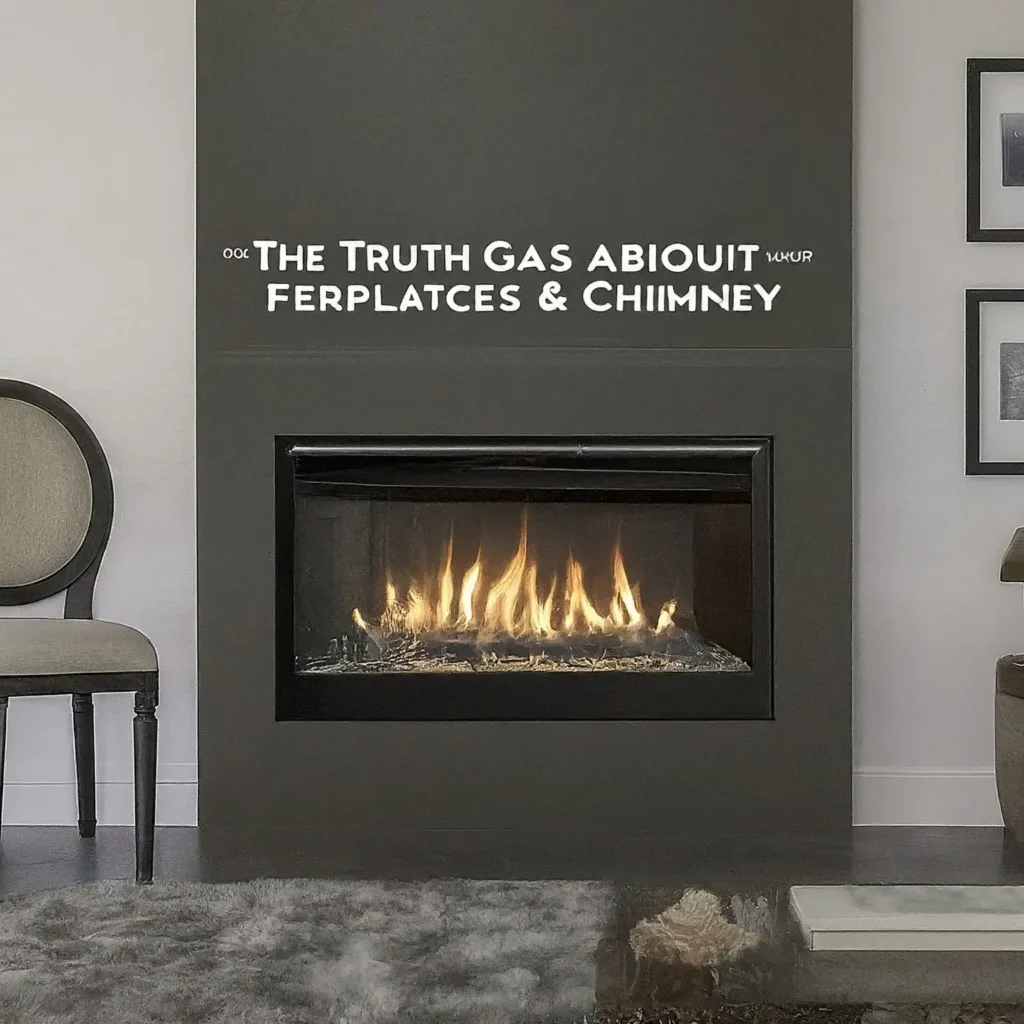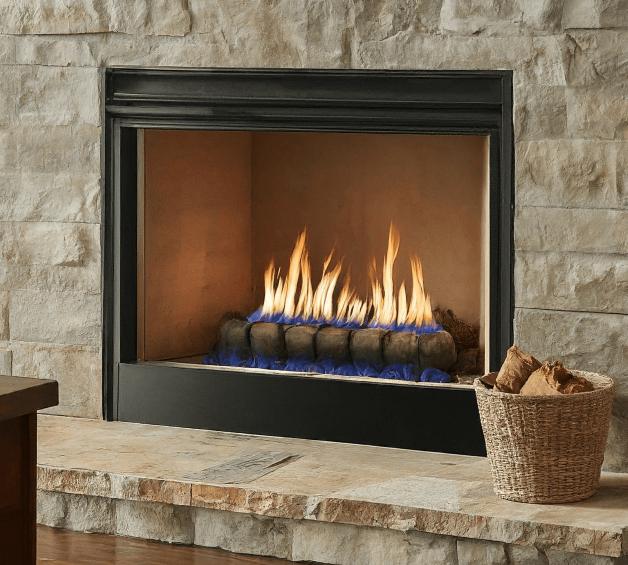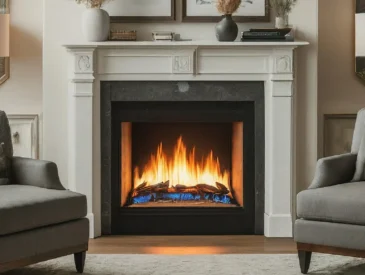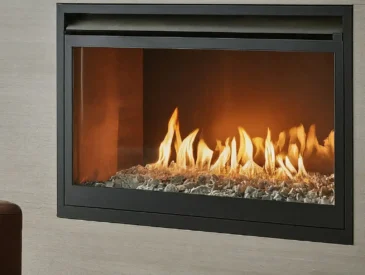A gas fireplace is a popular way to bring in the cozy comfort of a fire without the mess and labor of a wood-burning fireplace. However, a common question is whether or not gas fireplaces need a chimney to function correctly.

Gas fireplaces typically don’t need a chimney. However, some gas fireplaces, like direct-vent and B-vent, require a vent and can use an existing chimney for that. A ventless gas fireplace doesn’t need a chimney or a vent system. It depends on your gas fireplace’s venting system.
The three different gas fireplace systems (ventless, direct-vent, and B-vent) each have unique requirements for safe use. This guide will go over the different gas fireplace systems and discuss which ones need a vent or chimney system.
Do gas fireplaces need a Chimney?
Gas fireplaces don’t need a chimney, although they can use an existing one for venting fumes. Two types of gas fireplaces need a vent: direct-vent gas fireplaces and B-vent gas fireplaces. A ventless gas fireplace requires no venting or chimney for safe use.
To better understand why some gas fireplaces use a chimney and why some don’t, let’s discuss the different types of gas fireplaces and how they function.
This guide will look at three different gas fireplaces: ventless, direct-vent, and B-vent (also known as a natural vent).
Ventless Gas Fireplace
A ventless gas fireplace doesn’t require a vent or chimney. Instead, the fireplace uses room air to fuel the fire, producing little to no exhaust. Due to the low exhaust output, there is no vent. A ventless gas fireplace operates similarly to a gas stove—it runs safely inside a closed space.
The flame on a ventless gas fireplace is typically smaller and bluer in color. Therefore, compared to other gas fireplaces, a ventless gas fireplace has less of a resemblance to a wood-burning fire.
Since no vents are required, putting in a ventless gas fireplace is less invasive to your home and cuts down on the installation cost. Although they produce little exhaust, there is a risk of decreasing the oxygen levels in the room, as these types of gas fireplaces use the room’s oxygen to fuel the fire.
A ventless gas fireplace has a sensor to detect low oxygen levels. The detector will automatically shut off the fireplace when oxygen levels have reached an unsafe level, so you’ll always be safe.
Pros of a ventless gas fireplace:
- Lower installation costs.
- Low maintenance.
- It burns a safe and clean flame.
- It doesn’t require a glass front.
Cons of a ventless gas fireplace:
- Can increase the room’s humidity.
- Can decrease the room’s oxygen levels.
- Low resemblance to a traditional wood-burning fire (the flame is blue instead of classic yellow or orange).
- Less heat output.
Direct-Vent Gas Fireplace
A direct-vent gas fireplace uses vents to exhaust the fumes and byproducts of the fire while also circulating clean air to the fireplace. This system does require the use of a vent system, which can be directed through an existing chimney or installed through the walls with venting pipes.
A direct-vent system can have the vents installed vertically (straight up through a chimney or the roof) or horizontally (vented sideways through the walls to the outside). A direct-vent system is an excellent solution for homes that either don’t have a chimney or the ability to vent upwards.
Direct-vent systems are usually sealed units and don’t use room air for fueling the fire. The heat output is generally better, and many use a blower to push the warm air into the room. Furthermore, these systems produce a realistic flame.
Pros of a direct-vent gas fireplace:
- Vents can be installed horizontally or vertically.
- It can use an existing chimney.
- Great heat output.
- It burns a fire that more closely resembles a traditional wood-burning fire.
- It’s safe to use.
Cons of a direct-vent gas fireplace:
- More costly to install.
- A sealed unit means no access to flames.
- The fireplace location is limited to where the vents can reach the outside.
B-Vent Gas Fireplace
A B-vent gas fireplace uses a vent system that most closely resembles a chimney. It is directed straight up through an existing chimney or a pipe vent to the roofline. A B-vent gas system requires a straight vent because it relies on the warm exhaust rising to vent outside the home.

The B-vent’s design heats the inside layer of the vent to encourage the warm air to rise and exhaust outside. The insulated vent also keeps the outside layer cooler to prevent overheating of the walls and surrounding material.
This system uses room air to fuel the fire and then exhausts the byproducts through the vent. Unfortunately, this means that the vent also loses warm room air.
Pros of a B-vent gas fireplace:
- The flames closely resemble that of a wood-burning one.
- Access to the flames.
- Good heat output.
Cons of a B-vent gas fireplace:
- More costly to install.
- Vertical venting only.
- May not exhaust all fumes.
- Heat is lost through the vent.
What Kind of Chimney Does a Gas Fireplace Need?
An existing chimney can hold the vent systems for gas fireplaces. If an existing chimney isn’t present in the home, then a traditional chimney isn’t required to be installed.
Instead, the gas fireplace uses a modified chimney or vent system. The only gas fireplace that requires no vent or chimney is a ventless system.
Ventless gas fireplaces are left out of this section because they don’t need an exhaust system. Instead, let’s discuss a direct-vent fireplace and a B-vent fireplace. These two systems do require an exhaust system.
An Existing Chimney
A direct-vent and a B-vent gas fireplace can use an existing chimney to route the vents outdoors. A direct-vent system uses two vents, one to exhaust and the second to intake clean air.
Two individual vents pipe up through the chimney, or a single, divided pipe is used. The size and condition of the chimney are essential. For example, a direct-vent fireplace cannot use a chimney that is too narrow or in disrepair.
A B-vent system directs one vent up through the chimney. The vent operates like a traditional chimney in the sense that it is solely used for exhausting fumes.
The warm fumes and smoke rise through the vent, closely resembling a wood-burning fireplace flue. The chimney must be large enough to accommodate the B-vent gas fireplace’s exhaust pipe.

No Existing Chimney
When a home doesn’t have an existing chimney, the vent runs through the walls—direct-vent fireplaces vent sideways through walls or directly up through the roofline. Conversely, a B-vent system will only vent up through the roofline.
The benefit of installing a gas fireplace in a home with no chimney over a wood-burning fireplace is that gas fireplaces do not need a traditional chimney. The cost of installing a brick-and-mortar chimney for a wood-burning fireplace is substantial.
Unless the gas fireplace is ventless, it does require vent installation.





